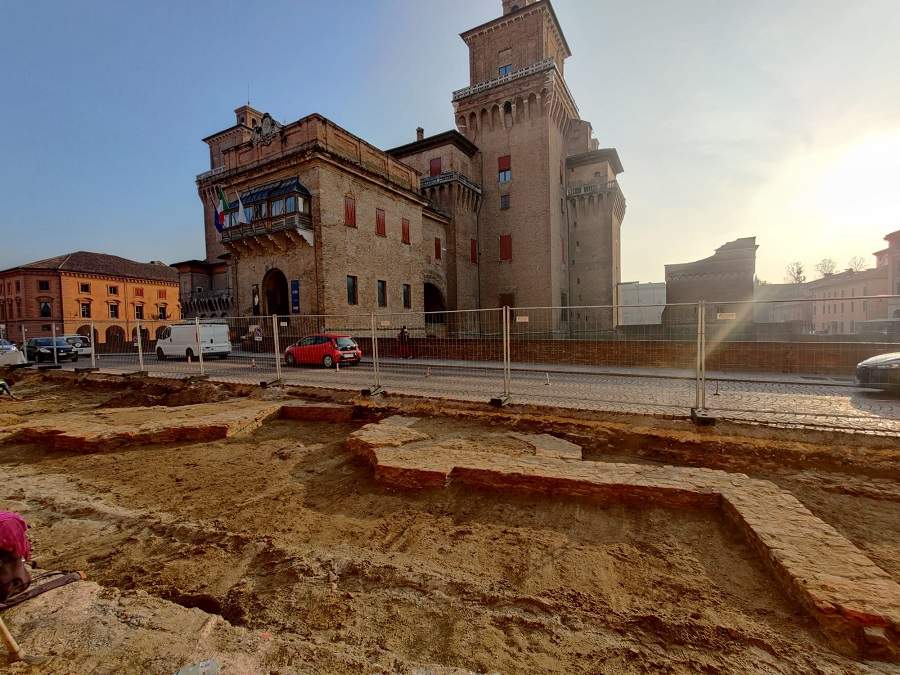More important archaeological discoveries from the ongoing excavation sites in Ferrara: after the duke’s “bath” at the Palazzo dei Diamanti and after the discovery of the base of the ancient northern entrance to the Estense Castle, it was just a few hours ago that the remains of the18th-century oratory of San Bernardino da Feltre were discovered, which was located right in front of the castle.
As explained by Ferrara’s head of protection, Chiara Guarnieri, who heads the team of four archaeologists from Phoenix archaeology commissioned by the Superintendency and constantly present on the site, the remains of the small building found can be traced precisely to “the oratory of San Bernardino da Feltre, linked to the Monte di Pietà, today’s palazzo della Borsa, and dating back to a period immediately after the mid-18th century. The oratory, from the traces that have emerged from the excavations, has a single, highly articulated plan. The building was destroyed in 1800, but we have descriptions and elevations of it: it had an east-facing facade.” In addition, other masonry that resurfaced from underground, visible now even to passersby, draws the configuration of other ancient buildings. “From the first surveys we hypothesize that the area facing to the right of the Castle (with one’s back to it) was occupied by buildings used for craft functions but also for residential use. There have emerged signs of fire, chimneys, wells, but also ceramic fragments, remains of plaster, some evidence of the everyday life of those who lived and worked here.” Historical investigations continue, parallel to the construction site, and will now focus on the area towards Borgo dei leoni Street.
In fact, several finds have emerged from the excavation: new portions of the perimeter of the ancient neighborhood, part of the old craft area, courtyards of dwellings, signs of fire, chimneys, wells. Also: ceramic fragments, remains of plasters. These are several historical elements that are emerging from the excavations in largo Castello, while the repaving works continue (carried out, with an investment of 600 thousand euros, by “Porfidi delI’Isola” Srl of Bonate Sopra). The news has led Administration and Superintendence to arrange drone surveys that will converge into a documentary on the new signs of the past that the intervention in front of the Castle has made it possible to identify. “The excavations, after decades,” said Mayor Alan Fabbri, “have brought to light historical elements that we want to enhance, promote, make known and even bring to schools. Hence the decision to document the findings and explain, in a dedicated video, the new traces of history that have emerged. It will also be a way to enhance the valuable and passionate work of the archaeologists who have been, with painstaking patience, studying and analyzing the excavation area for months. Thanks to Dr. Chiara Guarnieri, who is coordinating this important work, for the great contribution she is making to the historical knowledge of our city’s past.”
The new themes at the center of the archaeologists’ investigation are in addition to some additional knowledge gained regarding other findings, such as the ancient ravelin (an element of the fortification detached from the city walls and placed in an advanced position) of the Castle, the base of which has been mapped in its entirety and which extends into the street portion on the side of the Borsa Palace.
Pictured: the area of the former oratory.
 |
| More discoveries in Ferrara: remains of 18th-century Oratory found in front of Castle |
Warning: the translation into English of the original Italian article was created using automatic tools. We undertake to review all articles, but we do not guarantee the total absence of inaccuracies in the translation due to the program. You can find the original by clicking on the ITA button. If you find any mistake,please contact us.